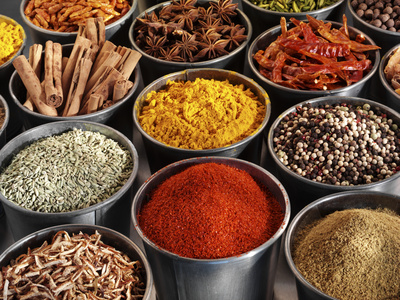Nature offers an abundance of natural sources of flavouring substances, providing an infinite range of tastes in food. Flavours have been added to foods since ancient Egyptian times, with the use of herbs and spices and aromatic extracts and oils. Modern natural flavours provide the consumer with a wider sensory experience and have the added advantages of consistency of flavour and enhanced consumer safety. Flavourings are ingredients that are added to foods in very small amounts, either to give a specific flavour to a product, such as a soft drink, boiled sweet or yoghurt; or to enhance or replace flavour lost during food processing. Flavourings can either be produced by extracting the aromatic compounds from foods, or by manufacturing new compounds to excite our taste buds.
Leading flavour powder suppliers and ace food flavour manufacturers in India have researched and churned out some of the best natural flavours. These food flavours are a mix of a variety of spices, which has a certain flavour type and can be directly used in food flavourings. The ever-increasing variety of spices and the improvement of flavour technology have promoted the rapid development of the flavours industry. In today’s times, most of the flavours are increasingly used in perfumed products as well. Food flavours have a wide range of uses and a wide variation, and there are different classification methods according to different purposes:
-
CLASSIFICATION ACCORDING TO FLAVOURS TYPE:
According to the flavours type, the natural flavours can be divided into;
- Fruit
- Meat
- Seafood
- Vegetables
- Nuts
- Dairy
- Spices
- Flowers
- Herbs
- Alcohol
- Tobacco
Each of which is further divided into many specific flavour types. Such as rose, jasmine, orange, lavender, vanilla, etc.
-
CLASSIFICATION ACCORDING TO DOSAGE FORM OF FLAVOURS:
Under this classification, natural flavours can be divided into;
- Liquid flavours
- Water-soluble flavours
It is prepared by mixing natural spices and synthetic flavours with an ethanol aqueous solution. It is mainly used in soft drinks in the form of soft drink concentrates, frozen food and alcohol.
-
Oil-soluble flavours
It is made by dissolving natural perfume and synthetic perfume in an oily solvent or directly mixed with natural perfume and synthetic perfume. It is primarily used for flavouring candy, biscuits and so on. Cardamom flavours, caramel flavours, almond flavours, and highly aromatic oil-soluble essences from Fab Flavours are taking the flavour marketplace by storm.
-
Emulsified flavours
It is the use of appropriate emulsifiers and stabilizers to disperse the flavours group into particles in water, mainly used in soft drinks.
- Powder flavours
- The powder flavours are made from grinding and mixing of the solid flavours
- The powder flavours made of the powder support absorption flavours
- Micro Encapsulated powder flavours coated by excipient.
- Ointment (Pulp) flavours
Paste flavours are usually mixed and used to make the fragrance of the product more coordinated and plumper.
-
CLASSIFICATION BY THE USE OF FLAVOURS
Prominent Juice flavour manufacturers are elevating the consumers’ tastebuds by offering candy flavours, beverage flavours, dairy flavours, seasoning flavours, meat flavours and bakery flavours, each of which can be subdivided into further food flavour essences.
-
CLASSIFICATION BY THE SOURCE OF FLAVOUR SUBSTANCES
According to the source of flavour substances, there are thermal reaction types, blending types, oxidation types, fermentation types and enzymatic hydrolysis flavours and so on.
-
CLASSIFICATION BY THE MAIN FLAVOUR
These are mainly used in instant noodles, condiments, expanded food and meat products, beverages, ice cream, jelly and other industries.
Apart from the above classification, there are three major categories:
| NATURAL FLAVOURS | PROCESSED FLAVOURS | ADDED FLAVOURS |
| · Herbs- Basil, mint
· Spices- Cardamom, Clove, Turmeric · Aromatic seeds- Aniseed, cumin · Fruits- Orange, Lemon flavours · Vegetables- Peas, onion, garlic
|
· Caramelized
· Roasted · Fermented · Toasted · Bakery flavours |
· Natural extracted flavour
o Essential oil o Essence o extracts · Synthetic flavour o Fruit flavour o Savoury flavour |
FLAVOUR ENHANCERS:
They are chemicals that by themselves have little or no odour or taste. When they are added to food, even in small quantities, they bring out the flavour of the food. They are capable of enhancing, modifying, or intensifying the original flavour. These flavour enhancers include MSG (monosodium glutamate), nucleotides, maltol, salt, and sodium-restricted flavouring.
The use of flavour in food preparation helps in retaining the natural flavour while processing. An understanding of volatile and non-volatile flavours is necessary. Flavour often is lost when food becomes stale. The flavours used in different foods can be altered, modified or intensified by the flavourings used.
So why wait? Allow your taste buds to experiment with the widest range of food flavours from the best flavours manufacturers in India today!


